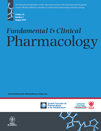Effects of induced hyperthermia on pharmacokinetics of ropivacaine in rats
Abstract
Ropivacaine is a local anaesthetic used for epidural anaesthesia and postoperative pain relief. Hyperthermia is a very common sign of infection associated with variations in physiological parameters, which may influence drugs pharmacokinetics. The aim of this study was to determine the effects of induced hyperthermia on ropivacaine pharmacokinetics in rats. Two groups of six rats were given a single subcutaneous ropivacaine injection. Hyperthermia-induced animals were placed in a water bath to obtain a stable mean core temperature of 39.7 °C. After blood samples collection, ropivacaine serum concentrations and pharmacokinetic parameters were determined. Two other groups of six rats were sacrificed 30 min after ropivacaine injection to determine serum and tissues (brain and heart) concentrations. Our results (median ± inter quartile range) reveal a significant increase of the total apparent clearance (0.0151 ± 0.000800 L/min vs. 0.0134 ± 0.00134 L/min), apparent volume of distribution (Vd) (2.19 ± 0.27 L vs. 1.57 ± 0.73 L) and a significant decrease in exposure (488 ± 50.6 mg.min/L vs. 572 ± 110 mg.min/L) in induced-hyperthermia group. We observed a significant increase in brain ropivacaine concentration in hyperthermic rats (8.39 ± 8.42 μg/g vs. 3.48 ± 3.26 μg/g) and no significant difference between cardiac concentrations in the two groups (5.38 ± 4.83 μg/g vs. 3.73 ± 2.44 μg/g). Results suggest a higher tissular distribution of ropivacaine and an increase in blood–brain barrier permeability during hyperthermia. The hyperthermia-induced increase in Vd could be responsible for an increase in cerebral ropivacaine toxicity. These experimental data provide a basis for future clinical investigations in relation to local anaesthetic use in hyperthermic patients.




